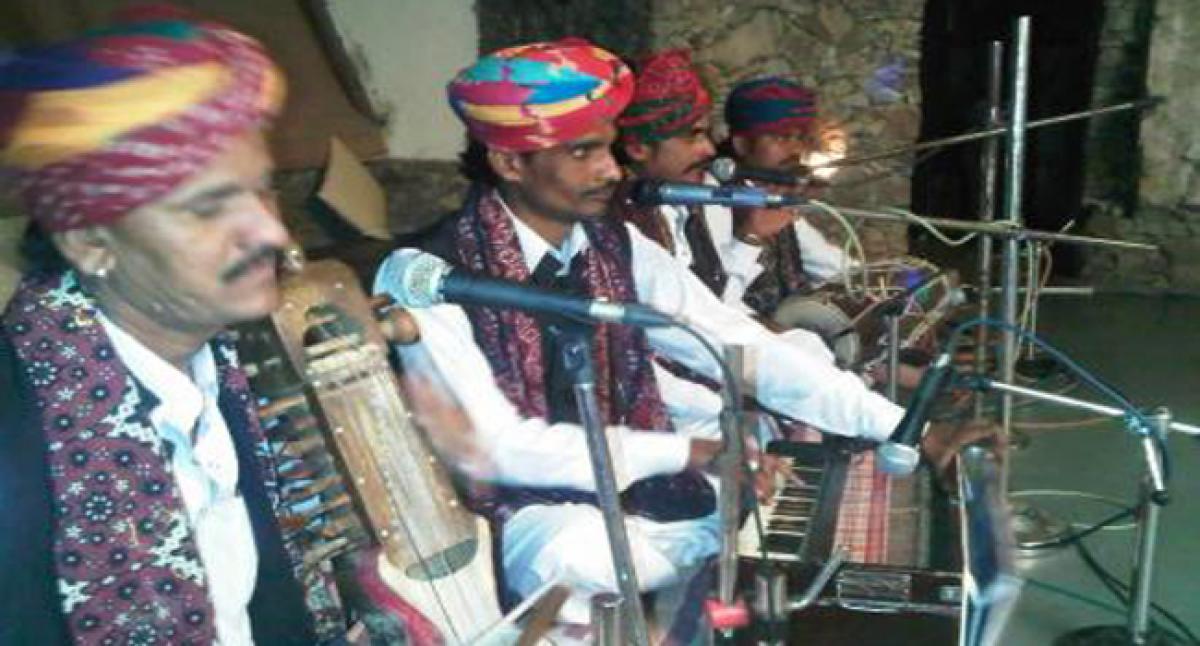Live
- Nortje ruled out of SA’s remaining white-ball matches against Pakistan
- Mamata doesn't want INDIA bloc to succeed, claims BJP's Rahul Sinha
- Air India Express cancels flights at Chennai airport due to deluge
- Kejriwal promises Rs 2,100 for Delhi women if AAP wins polls, BJP takes ‘lollipop’ jibe
- JPC Chairman supports Assam govt's 'No NRC, No Aadhaar,' rule
- Stoinis vows to revive Melbourne Stars’ glory with fresh leadership
- DDA easing freehold conversion of shops: MoS Sahu
- CP Sudheer Babu Updates on Manchu Family Cases
- Keerthy Suresh Marries Long-time Friend Antony Thattil in Goa
- Siddaramaiah govt defends police action on Panchamasali Lingayat protesters
Just In

They are Muslims, yet they sing Krishna \"bhajans\" (hymns) from Hindu lore. They have adopted a hybrid culture that is a mix of both religions and lifestyles. Many of their names too blend two religions, like Shankar Khan and Krishna Khan.
They are Muslims, yet they sing Krishna "bhajans" (hymns) from Hindu lore. They have adopted a hybrid culture that is a mix of both religions and lifestyles. Many of their names too blend two religions, like Shankar Khan and Krishna Khan.
They are the Manganiyaars, who hail from western Rajasthan, where a thriving legacy of secular music has touched the hearts of music lovers not just in India but in many countries across the world where they have played. But they remain a struggling lot at home.
According to Manjoor Khan, a grandly-turbaned Manganiyaar folk singer, their art has flourished under the Rajputs. "Hindu Rajputs have kept our legacies live; they have protected us and kept our art living and thriving. For years, we have been singing for them," Khan said.
Manganiyaars' music blends the traditions of Hindustani and Sufi music. Many generations were connected to both Muslim and Hindu families to earn their livelihood where they sang and composed music for their "jajmaans" (patrons).
The Manganiyaars story is incomplete without mentioning Langas, their musical cousins. Langa means "song giver" and includes poets, singers, and musicians from Barmer. They too had expertise in Sufi singing and hence their patrons, unlike the Manganiyaars, were Muslims.
Bhungar Khan Manganiyaar, who now performs in countries like Australia, UK, Sweden, Norway, Germany and Russia, complains that this age-old legacy lacks the required support from the government in India and the new age generation is losing interest in this music.
Earlier, their music was limited to the borders of western Rajasthan, but now even Bollywood seems quite influenced with their magic. Recently, two children of these communities made it to Bollywood chartbusters. The credit for getting their music some national and international attention goes to Komal Kothari, who brought the traditional musicians before a larger, even global, audience.
Also known as Komalda, he was the first to record the Manganiyars for a radio programme. Awarded Padma Shri and Padma Vibhushan for his exceptional work in the field of music, he was an Indian folklorist and ethno-musicologist from Jodhpur.
In 1960, he met Antar Khan, a Manganiyar, on the street, and soon he took him to his office. As he was preparing his vintage tape recorder to record him, he saw him disappear. When chased and caught, the poor man said that he feared his voice might be swallowed by a recording machine if he sang in front of it.
Kothari started making quick trips to Jaisalmer, in Manganiyar country, to talk to them on earning a new livelihood. In 1962, the first recording of Langa music took place. In 1963, a Manganiyar troupe performed in Delhi, for the first time on stage. But Kothari wanted to showcase them to world.
In 1967, he traveled to Sweden with Langa troupe for their maiden performance outside India. Soon the Indian Council of Cultural Research (ICCR) got into the act. By the time India staged the popular Festivals of India all over the world in the mid-eighties, Manganiyars and Langas had become the darlings of international audiences.
Today, Rajasthan's tourism industry is driven quite substantially by these charismatic performers. But they fear that without institutionalised support, their tradition may just die out.
By Archana Sharma

© 2024 Hyderabad Media House Limited/The Hans India. All rights reserved. Powered by hocalwire.com







